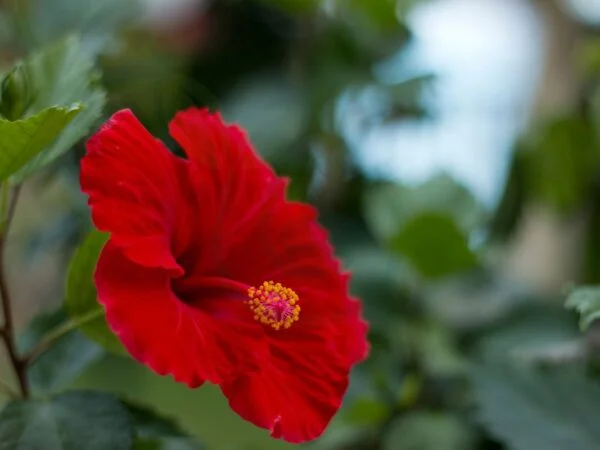Looking to master the art of hard pruning hibiscus in spring with pruners? You've come to the right place. With our expert guidance, you'll learn the dos and don'ts of this essential gardening task, including corrective pruning.
Wondering when and how to do heavy pruning, maintenance pruning, hard pruning, or corrective pruning on your hibiscus plants for optimal growth and blooming? In this comprehensive guide, we'll walk you through the step-by-step process, ensuring your hibiscus thrives throughout the season. From tools needed to best practices, we've got you covered.
Ready to elevate your gardening skills and achieve stunning hibiscus blooms? Stay tuned for valuable tips, tricks, and insights that will transform your pruning routine and help your hibiscus plants flourish like never before.
Key Takeaways
-
Prune hibiscus in spring: Timing is crucial for effective pruning, so aim to cut branches of your hibiscus in the spring months using pruners.
-
Identify pruning nodes: Locate the right spots on branches to cut for optimal growth and flowering.
-
Use effective techniques: Prune and cut branches, employ proper pruning methods to shape your hibiscus in the garden, and encourage healthy growth.
-
Stimulate new growth: By pruning correctly, you can promote the development of new branches, flowers, and blooms in the garden.
-
Care after pruning: Provide post-pruning care, such as watering and fertilizing, to support your hibiscus's recovery.
-
Avoid common mistakes: Learn from common pruning errors to ensure the best results for your hibiscus plants.
Pruning Basics
What is Pruning
Pruning involves cutting back branches and wood to encourage growth and flowering in hibiscus plants. Different techniques like pinching, selective pruning, full prune, rejuvenating prune, corrective pruning, and cutting branches can be used. The process is essential for maintaining a healthy and balanced hibiscus plant.
Why Prune
Pruning stimulates branching and promotes fuller bushes, leading to increased flower production. It results in more blooms and visually appealing hibiscus plants. Pruning helps shape the plant by cutting stems and eliminating dead or damaged branches.
When to Prune
Timing is crucial in pruning, especially before a warming trend to encourage active growth. Guidelines suggest late fall, spring, or summer as ideal pruning times based on climate conditions. For optimal results, hard pruning should be done in spring.
Preparing to Prune
Inspect Your Plant
Before pruning your hibiscus in spring, carefully examine the plant and branches for any dead wood, weak growth, or signs of disease. It's crucial to pinpoint areas, such as branches, that require pruning to promote a healthy plant. Take time to evaluate the overall condition of the hibiscus before initiating the pruning process.
Choosing Tools
When it comes to maintenance pruning of hibiscus in the garden, ensure you have sharp and clean pruning shears as your primary tool to cut branches. Using the right tools is essential to avoid spreading diseases among plants. Remember to keep your tools well-maintained for efficient and effective pruning sessions.
Identifying Pruning Nodes
Find Suitable Node
To find suitable nodes for cutting during pruning, look for areas where leaves meet the stem. Select nodes strategically to promote healthy growth by ensuring they are not too young or old. It is crucial to choose the right nodes as they encourage new branches and blooms.
Node Types
Hibiscus plants have various node types, including vegetative and floral nodes. Vegetative nodes support leaf growth, while floral nodes give rise to flowers. Understanding these node types is essential for successful pruning, as it determines where new growth and blooms will emerge. Make sure to identify each type accurately before proceeding with the pruning process.
Effective Pruning Techniques
Live Wood Inspection
Checking Vitality
Inspect branches before pruning to assess health and determine the extent of pruning needed. This step is crucial for promoting new growth and ensuring overall plant health.
Spotting Live Wood is essential during hibiscus pruning to preserve healthy branches. Identifying live wood contributes significantly to successful pruning outcomes.
Dead Wood Removal
Two Strategies
Two primary pruning strategies for hibiscus include selective pruning and hard pruning. Understand the differences and apply each based on the plant's condition and desired outcome.
Safety Measures are vital during hibiscus pruning. Always wear gloves, protective eyewear, handle sharp tools carefully, and exercise caution when climbing ladders.
Specialized Pruning Methods
Hard Prune Old Hibiscus
When pruning old hibiscus plants with significant dead wood and weak growth, begin by cutting back the plant aggressively. Trim down to one foot above soil level, ensuring a healthy rejuvenation process. This method stimulates new growth, promoting a fuller and more vibrant plant.
To maintain the health of hibiscus tree standards, it is vital to follow specific pruning techniques. Focus on trimming the top branches to encourage upward growth and abundant flowering. Regular pruning not only maintains the desired shape but also supports overall plant vitality.
Prune Hibiscus Tree Standard
For hibiscus tree standards, prune by targeting the upper portion of the plant to promote vertical growth and blooming. By trimming strategically, you guide the plant's energy towards the top, resulting in a well-shaped and blossoming tree standard. Consistent pruning ensures continued health and aesthetic appeal.
When creating a hibiscus tree standard from a young plant, start by selecting a healthy specimen with a strong central stem. Train the plant to grow vertically by regularly pruning side shoots and shaping the canopy. Developing hibiscus standards offers a distinctive addition to your garden, showcasing an elegant display of blooms at eye level.
Stimulating New Growth
Encourage Regrowth
To encourage regrowth after pruning hibiscus in spring, provide proper care and nutrients. Ensure the plant receives adequate sunlight, water, and a balanced fertilizer. By following these practices, you can stimulate the growth of new buds and green leaves. This process helps the hibiscus develop new branches and promotes a healthier, more robust structure overall.
Emphasize the importance of promoting new growth post-pruning. By maintaining a consistent watering schedule and applying a suitable fertilizer, you can ensure the hibiscus plant thrives. These actions not only aid in the development of new shoots but also contribute to the plant's resilience against pests and diseases. Overall, encouraging regrowth results in a more vibrant and visually appealing hibiscus plant.
Fertilizing After Pruning
After pruning your hibiscus, it is crucial to understand the significance of fertilizing to support new growth effectively. Select a well-balanced fertilizer with essential nutrients like nitrogen, phosphorus, and potassium to nourish the plant. Timing is key; apply the fertilizer during the growing season to maximize its benefits post-pruning.
When considering fertilization post-pruning, remember that it plays a vital role in promoting healthy foliage and abundant blooms on your hibiscus plant. The right type of fertilizer can provide essential nutrients that encourage new branch development and enhance overall plant vitality. By incorporating fertilization into your post-pruning care routine, you are ensuring optimal growth and blooming potential for your hibiscus.
Dealing with Damaged Hibiscus
Pruning Damaged Plants
To prune damaged hibiscus plants, start by inspecting the plant for any diseased or broken branches. Cut back these damaged areas using sharp and clean pruning shears. Removing the affected parts is crucial to prevent the spread of diseases within the plant. Pruning helps in promoting new growth, as it redirects the plant's energy towards healthier areas.
Recovery Tips
After pruning, ensure proper watering and adequate sunlight exposure for the hibiscus plant. Water the plant deeply but infrequently to encourage healthy root growth. Provide sufficient sunlight for at least 6-8 hours a day to support photosynthesis and overall plant recovery. Be patient as the plant regrows post-pruning; it may take some time for new growth to appear.
Following these recovery tips is essential for the successful healing and growth of pruned hibiscus plants. By providing optimal conditions, you can aid in the rapid recovery of your hibiscus after pruning. Remember that consistent care and attention are key to supporting your plant's journey back to full health.
Post-Pruning Care
Immediate Aftercare
After pruning hibiscus in spring, it's crucial to focus on immediate aftercare. Water the plants adequately, ensuring the soil remains moist but not waterlogged. Shield them from harsh weather conditions like strong winds or excessive sunlight. Providing proper care immediately post-pruning is essential for supporting the plant's health and recovery. Neglecting this step can hinder growth and flowering.
Immediate aftercare significantly impacts the success of pruning outcomes for hibiscus plants. By promptly addressing their needs, you set the stage for robust growth and vibrant blooms. Remember, a little attention now goes a long way in fostering healthy, thriving hibiscus plants.
Long-Term Maintenance
In addition to immediate aftercare, long-term maintenance is key for ensuring the continued health and vitality of your pruned hibiscus plants. Consistent practices such as regular watering, ideally with a deep soak once a week, are vital to support their growth. Fertilize the plants appropriately to provide essential nutrients for sustained flowering and overall health.
Long-term maintenance post-pruning is critical for sustaining the beauty and vigor of hibiscus plants over time. By establishing a routine that includes watering, fertilization, and monitoring for pests or diseases, you contribute to their longevity and resilience. Remember, ongoing care is not just beneficial but necessary for long-lasting plant health.
Common Pruning Mistakes
Avoiding Errors
Pruning hibiscus plants in spring demands precision to avoid common mistakes. Over-pruning can stunt growth, while cutting too close to nodes may harm the plant. To prevent these errors, maintain a balance by trimming just the right amount.
To ensure successful pruning and promote plant health, it's crucial to avoid mistakes. Pay attention to the timing, technique, and tools used during the process. By being cautious, you can maintain the vitality of your hibiscus plants.
Expert Tips for Success
After pruning hibiscus in the garden, observe how the plant responds to the trimming. This hands-on approach allows you to assess the impact of your pruning techniques. Consider implementing advanced strategies or tricks to further enhance pruning outcomes.
Continuous learning and experimentation are key to mastering hibiscus pruning techniques. By staying updated on best practices and trying out new methods, you can improve your skills over time. Remember, each hibiscus plant may respond differently to various pruning approaches.
Final Remarks
You've now mastered the art of pruning your hibiscus plants in spring. Remember the basics, identify those pruning nodes, and employ effective techniques to ensure healthy growth. Don't forget about specialized methods for different scenarios and always aim to stimulate new growth post-pruning. Be vigilant in dealing with any damaged parts and provide the necessary care afterward. Avoid common mistakes to guarantee optimal results.
Now, grab those pruners and put your newfound garden knowledge into action. Your hibiscus plants will thank you with vibrant blooms and lush foliage. Share your success with fellow gardeners and keep refining your skills. Happy pruning!
Frequently Asked Questions
How should I prepare to prune my hibiscus in spring?
To prepare for pruning your hibiscus in spring:
-
Gather clean, sharp pruning shears
-
Wear gardening gloves for protection
-
Familiarize yourself with the different parts of the plant you will be pruning
Can you explain the basics of effective pruning techniques for hibiscus?
Effective pruning techniques for hibiscus include:
-
Cutting at a 45-degree angle
-
Removing dead or diseased branches first
-
Trimming just above a node or bud
-
Avoiding over-pruning to maintain plant health
What are specialized pruning methods that can be used on hibiscus plants?
Specialized pruning methods for hibiscus include:
-
Pinching: Encourages bushier growth
-
Heading back: Controls size and shape
-
Thinning: Removes excess growth for better air circulation
How can I stimulate new growth after pruning my hibiscus?
To stimulate new growth after pruning:
-
Water the plant appropriately
-
Apply a balanced fertilizer
-
Ensure the plant receives adequate sunlight and warmth
What are common mistakes to avoid when pruning hibiscus plants?
Common pruning mistakes to avoid:
-
Pruning at the wrong time of year
-
Using dull or dirty tools
-
Removing too much foliage at once
-
Neglecting post-pruning care
Image Source: Paid image from CANVA



